Regulation of different types of PFAS
|
Senior Research Officer, Parliamentary Research Service
Per and polyfluoroalkyl substances (PFAS) are widely used chemicals often referred to as ‘forever chemicals’ because they do not readily break down in the environment. Because PFAS have been linked with adverse health effects, cases of drinking water contamination have prompted considerable community concern in NSW. However, the 3 types of PFAS currently regulated in drinking water in Australia (PFOS, PFOA and PFHxS) represent only a small fraction of the thousands of types of PFAS.
Data on the health effects of these other PFAS types are limited, but it is clear that some have the potential to be as harmful as PFOS, PFOA and PFHxS, others seem to be less harmful, and all are environmentally persistent. Regulators face considerable challenges in determining which of these PFAS warrant regulation. This paper considers case studies of how different jurisdictions have approached these challenges, which PFAS they have chosen to regulate, and current debates that are shaping these decisions.
|
| Key points
-
PFAS (per and polyfluoroalkyl substances) form a class of thousands of environmentally persistent chemicals used in a wide range of applications. Some PFAS types, such as PFOS, are associated with adverse effects on human health and have prompted considerable community concern in NSW.
-
Regulated PFAS such as PFOS have often been replaced with other types of PFAS. Some of these are less toxic in animal tests than the PFAS they have replaced. However, for most PFAS little health data is available, and there are major challenges in determining which types warrant restriction.
- Some scientists argue that filling the health evidence gaps for all PFAS types would be too costly and slow using standard chemical-by-chemical evaluation procedures. They propose that all PFAS should instead be restricted as a class on the basis of their environmental persistence. Other scientists argue that not all PFAS are harmful to health and many are essential for important technology.
 -
Scientists disagree not only on how to evaluate the risks of different types of PFAS, but on which particular substances should be considered PFAS.
-
Three types of PFAS are regulated in drinking water in Australia and a fourth will be regulated later this year. Some overseas jurisdictions regulate and report on more types of PFAS in drinking water; in some cases dozens of individual types are regulated.
-
Some jurisdictions argue that the health effects of exposure to different types of PFAS are likely to be cumulative and therefore apply regulatory limits to the sum of the concentrations of regulated PFAS.
-
Some jurisdictions are beginning to restrict the use of all PFAS types, but it is not yet technically feasible to monitor drinking water levels for all types of PFAS.
|
Members and parliamentary staff can request research by emailing [email protected].
Access Parliamentary Library resources and learn more about us including our service guide on the parliamentary intranet (internal users only).
Media contact: [email protected].
